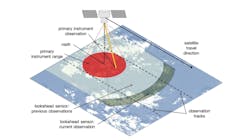NASA demonstrates AI system for smarter satellite imaging
WASHINGTON - In a recent test, NASA showed how artificial intelligence-based technology could help orbiting spacecraft provide more targeted and valuable science data. The technology enabled an Earth-observing satellite for the first time to look ahead along its orbital path, rapidly process and analyze imagery with onboard AI, and determine where to point an instrument. The whole process took less than 90 seconds, without any human involvement, NASA's Jet Propulsion Laboratory reports. Continue reading original article.
The Military & Aerospace Electronics take:
25 July 2025 - NASA has successfully tested a new artificial intelligence-based system that enables Earth-observing satellites to autonomously decide where to aim their sensors, reducing wasted data and improving science returns. The system, called Dynamic Targeting, allows a satellite to look ahead along its orbital path, process imagery onboard using AI, and determine whether or not to collect data based on conditions - all in under 90 seconds without human input.
The first flight test took place in July aboard CogniSAT-6, a CubeSat built by Open Cosmos using AI technology from Ubotica. The aim was to demonstrate the system's capacity to detect clouds in advance and avoid capturing images of them, as clouds can obscure the Earth's surface up to two-thirds of the time. When clear skies are identified, the spacecraft takes a picture; if not, it conserves storage and power for better opportunities.
Dynamic Targeting has been under development at NASA's Jet Propulsion Laboratory for over ten years. It mimics human decision-making by identifying features like clouds or fires and responding in real time. The system employs a small AI processor to analyze visible and infrared images and plan camera movements accordingly.
Related: Keeping a watchful eye on Earth observation and weather forecasting
Related: Orion Space Solutions to support NOAA's digital twin program for earth observation
Jamie Whitney, Senior Editor
Military + Aerospace Electronics
